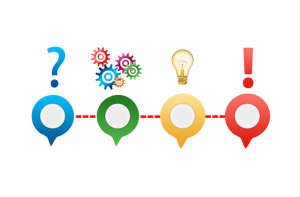Welcome to our second instalment of our new blog series Tell Us About Your Methodology. We are thrilled to be able to find out more about what our PGR cohort are currently working on, and this month we share with you an interview with 3rd year PhD candidate Jillian Manner (Health in Social Science)
What methodology are you using?
The intervention development framework that will be used throughout the PhD project is Six Steps in Quality Intervention Development (6SQuID). The 6SQuID framework facilitates the design, development of effective, acceptable, and sustainable interventions through collaboration and innovation.
What are the key aspects of this methodology?
The 6SQuID framework consists of the following six steps: 1. Defining the problem 2. Identifying modifiable and non-modifiable causal factors 3. Defining the theory of change 4. Defining the theory of action 5. Testing and refining the intervention 6. Collecting sufficient evidence of effectiveness to justify rigorous evaluation/implementation.
Why did you choose this methodology?
6SQuID was chosen because it is specifically designed for developing complex health interventions and provides clear practical steps for the framework’s implementation. 6SQuID emphasises pre-intervention development work by prompting the researcher to clearly identify the problem and investigate the contributory factors (steps 1 and 2) prior to planning intervention activities. Clarifying the specific problem you are looking to solve creates a strong rationale and foundation for the development of any intervention. For my PhD, I am looking to support contact centre organisations to improve their employee wellbeing programmes by changing factors tied to their work culture. Using 6SQuID allowed for the complex problems and factors related to each organisation’s unique organisational culture, and the associated barriers it creates, to be fully understood before attempting to change or modify them.
Why would you recommend this methodology?
I would absolutely recommend it to anyone who is looking to develop a complex public health intervention, or even just identify a complex public health problem and its causes. The steps are easy to follow, and the associated textbook provides a step-by-step approach for how to implement the framework in a range of settings. There are also some examples in the literature, and a few PhD theses (including mine) which provide good examples of how this has been applied to solve a real complex public health problem.
What additional training / help was needed to use your methodology?
Although I had been working with the framework prior to starting my PhD, the beauty of 6SQuID is that it is fairly easy to understand and apply if you have the textbook. I did have a lot of support from my supervisor, Professor Ruth Jepson, who is the main author of the textbook, so that certainly helped! If you are interested in using this framework, feel free to get in touch. I am happy to provide some guidance and/or signpost you to someone who can: Jillian.Manner@ed.ac.uk.

What are the benefits of this method?
In addition to what I have already mentioned, the 6SQuID framework emphasises co-production by developing and maintaining relationships with stakeholders and end-users throughout the intervention development process. Including them in identifying the problem and developing the solution is key and encouraging then to have ownership over the process is important in ensuring the solution (intervention) is acceptable and sustainable. Real-world interventions do not operate in silos. As such, the framework emphasises a systems-based approach. Considering the system in which the intervention will take place allows for increased implementation success and acceptability.
What are the challenges of using this methodology?
Understanding what data you want to collect throughout the process is important, especially if you are using the framework for research purposes (as opposed to as a practitioner). There are many different options at each stage of the process, and it can be challenging to choose the most appropriate, practical, and feasible ones. I found this difficult because I wanted to crack on with the process but had to stop myself to consider what data I was going to collect to evidence my decisions and ‘tell the story’ of how I worked through each of the steps. I also would have planned out how each step was to inform my thesis during the study design phase. I am doing this now (third year), but it would have been more efficient to plan them together. The process takes a long time, and it is unlikely that you will be able to complete the steps within the timeframe of a PhD. For example, I am likely (partially) to get to step 5 during my PhD. Depending on the scope of the problem and the chosen solution(s), cycling through all 6 steps could take years and multiple projects or rounds of funding. However, this is not all that different to other intervention development and testing methodologies.
Where can I find more information about this (e.g., key publications)?
Textbook: Jepson, R., Williams, A. J., Doi, L., & Buelo, A. (2021). Developing Public Health Interventions: A Step-by-Step Guide. SAGE.
Original article: Wight, D., Wimbush, E., Jepson, R., & Doi, L. (2016). Six steps in quality intervention development (6SQuID). Journal of epidemiology and community health, 70(5), 520-525. https://doi.org/10.1136/jech-2015-205952
What errors / limitations did you wish you would have spotted earlier?
I wish I had given myself more time for each of the steps and thought more about data collection and analysis. I also wish I had decided on this framework earlier in the PhD as it was straightforward to apply and helpful for what I wanted to accomplish!
What advice can you give to other people using this methodology?
Do not rush the process, particularly problem identification. Also, ensure you are using appropriate co-production methods. End-user involvement is crucial to developing effective and sustainable solutions to real-world problems. You don’t want to create something that people don’t want, and that isn’t going to solve the right problem!





